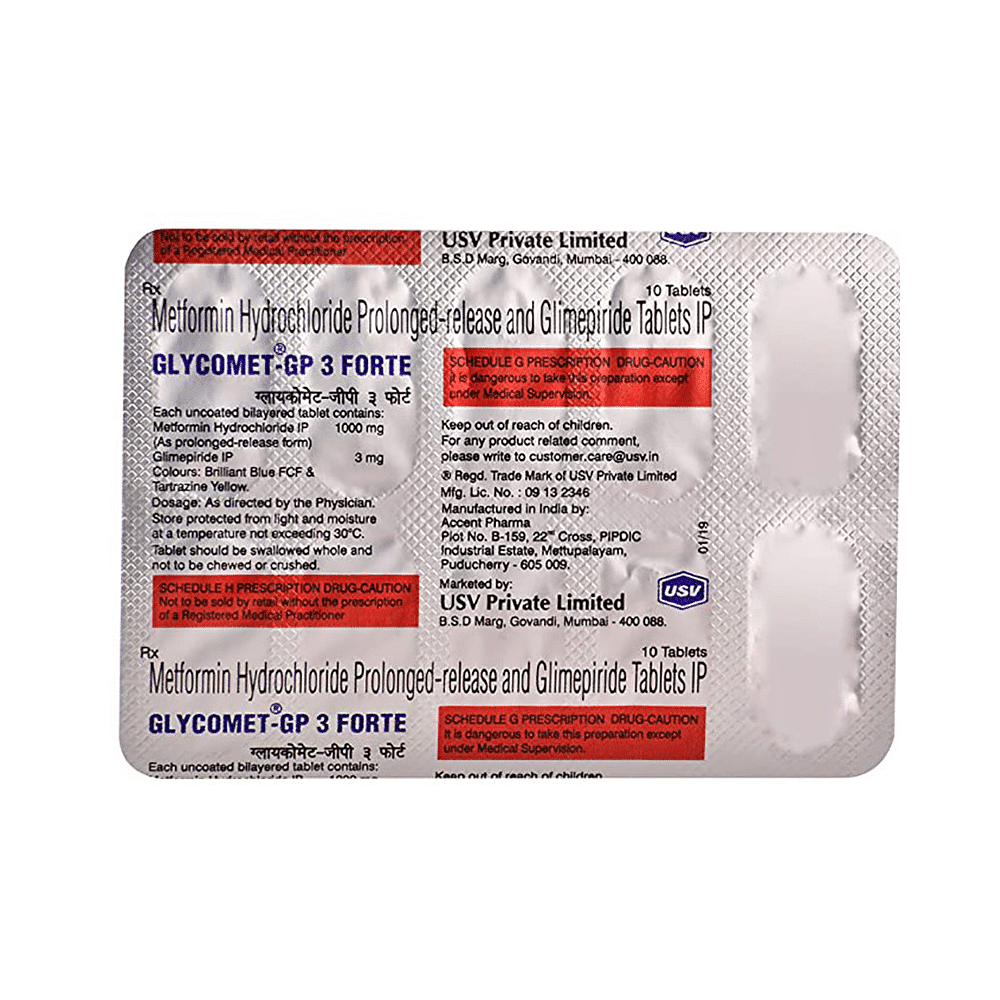
Glimidac M Forte 3mg/1000mg Tablet
Manufacturer
Daksh Pharma Pvt Ltd
Salt Composition
Glimepiride (3mg) + Metformin (1000mg)
Key Information
Short Description
Glimidac M Forte 3mg/1000mg Tablet is an anti-diabetic drug used to treat type 2 diabetes mellitus in adults by controlling blood sugar levels.
Dosage Form
Tablet
Introduction
Glimidac M Forte 3mg/1000mg Tablet belongs to a category of medicines known as anti-diabetic drugs. It is a combination of two medicines, Glimepiride and Metformin, used to treat type 2 diabetes mellitus in adults. This medication helps control blood sugar levels in people with diabetes. While it is effective in managing diabetes, it can cause side effects such as hypoglycemia, especially when used with other antidiabetic medicines or alcohol. It is important to monitor blood sugar levels regularly and inform your doctor if you experience symptoms like deep or rapid breathing, persistent nausea, vomiting, or stomach pain, as these could indicate a serious condition called lactic acidosis. Regular liver function checks may also be necessary.
Directions for Use
Take this medicine in the dose and duration as advised by your doctor. Swallow it as a whole. Do not chew, crush, or break it. Glimidac M Forte 3mg/1000mg Tablet is to be taken with food.
How it works
Glimidac M Forte 3mg/1000mg Tablet is a combination of two antidiabetic medicines: Glimepiride and Metformin. Glimepiride is a sulfonylurea which works by increasing the amount of insulin released by the pancreas in order to lower the blood glucose. Metformin is a biguanide which works by lowering glucose production in the liver, delaying glucose absorption from intestines, and increasing the body's sensitivity to insulin.
Quick Tips
You have been prescribed this combination medicine as it can control blood sugar better than metformin alone. You should continue to exercise regularly, eat a healthy diet, and take your other diabetes medicines along with Glimidac M Forte 3mg/1000mg Tablet. Take it with food to lower your chance of having an upset stomach. Monitor your blood sugar level regularly while you are taking this medicine. Inform your doctor about your diabetes treatment if you are due to have surgery under a general anesthetic.
Related Medicines

Glycomet-GP 3 Forte Tablet

Glimicer M Forte 3mg/1000mg Tablet

Defmet G Forte 3mg/1000mg Tablet

Glimijoy MF 3mg/1000mg Tablet

Glycilarc GP Forte 3mg/1000mg Tablet

Gliminn M Forte 3mg/1000mg Tablet

Ride M Forte 3mg/1000mg Tablet

Trueride M 3mg/1000mg Tablet

Glimtin M Forte 3mg/1000mg Tablet

Zetaglim M Forte 3mg/1000mg Tablet
Frequently asked questions
What are the recommended storage conditions for Glimidac M Forte 3mg/1000mg Tablet?
Keep this medicine in the container or the pack it came in, tightly closed. Store it according to the instructions mentioned on the pack or label. Dispose of the unused medicine. Make sure it is not consumed by pets, children and other people.
Can Glimidac M Forte 3mg/1000mg Tablet lead to lactic acidosis?
Yes, the use of Glimidac M Forte 3mg/1000mg Tablet can lead to lactic acidosis. It is a medical emergency caused by increased levels of lactic acid in the blood. This condition is known as MALA (Metformin-associated lactic acidosis). It is a rare side effect associated with the use of metformin and therefore considered harmful for patients with underlying kidney disease, elderly individuals or those who take large amounts of alcohol. Symptoms of lactic acidosis may include muscle pain or weakness, dizziness, tiredness, feeling of cold in arms and legs, difficulty in breathing, nausea, vomiting, stomach pain or slow heart rate. If you experience these symptoms, stop taking Glimidac M Forte 3mg/1000mg Tablet and consult your doctor immediately.
What is Glimidac M Forte 3mg/1000mg Tablet?
Glimidac M Forte 3mg/1000mg Tablet is a combination of two medicines: Glimepiride and Metformin. This medicine is used in the treatment of type 2 diabetes mellitus (DM). It improves blood glucose levels in adults when taken along with proper diet and regular exercise. Glimepiride lowers the blood glucose level by increasing the release of insulin from the pancreas. Metformin works by lowering the glucose production in the liver and improving insulin sensitivity. This combination is not indicated for the treatment of type 1 DM.
What are the possible side effects of Glimidac M Forte 3mg/1000mg Tablet?
The use of Glimidac M Forte 3mg/1000mg Tablet can be associated with common side effects like hypoglycemia (low blood sugar level), altered taste, nausea, stomach pain, diarrhea and headache. It can also lead to serious but rare side effects like lactic acidosis. On long-term use, it may also cause Vitamin B12 deficiency.
Can the use of Glimidac M Forte 3mg/1000mg Tablet lead to Vitamin B12 deficiency?
Yes, the use of Glimidac M Forte 3mg/1000mg Tablet can cause Vitamin B12 deficiency on long-term use. It interferes with the absorption of Vitamin B12 in the stomach. If untreated, it may cause anemia and nerve problems. The patient can experience tingling sensation and numbness in hands and feet, weakness, urinary problems, change in mental status and difficulty in maintaining balance (ataxia). To avoid such problems, some researchers suggest an intake of Vitamin B12 from outside sources at least once every year.
Can the use of Glimidac M Forte 3mg/1000mg Tablet lead to hypoglycemia?
Yes, the use of Glimidac M Forte 3mg/1000mg Tablet can cause hypoglycemia (low blood sugar level). Symptoms of hypoglycemia include nausea, headache, irritability, hunger, sweating, dizziness, fast heart rate and feeling anxious or shaky. This happens more often if you miss or delay your food, drink alcohol, over-exercise or take other antidiabetic medicine along with it. So, regular monitoring of the blood sugar level is important. Always keep a quick source of sugar like glucose tablets, honey or fruit juice with you.
Is it safe to take alcohol while I am also taking Glimidac M Forte 3mg/1000mg Tablet?
No, it is not safe to take Glimidac M Forte 3mg/1000mg Tablet along with alcohol, as it may lower your blood sugar levels and lead to hypoglycemia. It can also increase the chances of lactic acidosis.


